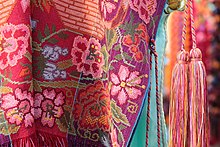



Textile is an umbrella term that includes various fiber-based materials, including fibers, yarns, filaments, threads, different fabric types, etc. At first, the word "textiles" only referred to woven fabrics.[1]: 3 [2]: 5 [3] However, weaving is not the only manufacturing method, and many other methods were later developed to form textile structures based on their intended use. Knitting and non-woven are other popular types of fabric manufacturing.[4] In the contemporary world, textiles satisfy the material needs for versatile applications, from simple daily clothing to bulletproof jackets, spacesuits, and doctor's gowns.[3][5][4]
Textiles are divided into two groups: consumer textiles for domestic purposes and technical textiles. In consumer textiles, aesthetics and comfort are the most important factors, while in technical textiles, functional properties are the priority.[4][6] Durability of textiles is an important property, with common cotton or blend garments (such as t-shirts) able to last twenty years or more with regular use and care.
Geotextiles, industrial textiles, medical textiles, and many other areas are examples of technical textiles, whereas clothing and furnishings are examples of consumer textiles. Each component of a textile product, including fiber, yarn, fabric, processing, and finishing, affects the final product. Components may vary among various textile products as they are selected based on their fitness for purpose.[4][7][6]
Fiber is the smallest component of a fabric; fibers are typically spun into yarn, and yarns are used to manufacture fabrics.[8][7] Fiber has a hair-like appearance and a higher length-to-width ratio. The sources of fibers may be natural, synthetic, or both. The techniques of felting and bonding directly transform fibers into fabric. In other cases, yarns are manipulated with different fabric manufacturing systems to produce various fabric constructions. The fibers are twisted or laid out to make a long, continuous strand of yarn.[2] Yarns are then used to make different kinds of fabric by weaving, knitting, crocheting, knotting, tatting, or braiding.[9][10][5] After manufacturing, textile materials are processed and finished to add value, such as aesthetics, physical characteristics, and increased usefulness.[11] The manufacturing of textiles is the oldest industrial art.[12] Dyeing, printing, and embroidery are all different decorative arts applied to textile materials.[13]
- ^ Joseph, Marjory L. (1977). Introductory textile science. New York : Holt: Rinehart and Winston. pp. 3, 4, 439. ISBN 978-0-03-089970-6.
- ^ a b Kadolph, Sara J. (1998). Textiles. Upper Saddle River, N.J.: Merrill. pp. 4, 5. ISBN 978-0-13-494592-7.
- ^ a b "textile | Description & Facts". Encyclopedia Britannica. Archived from the original on 2015-06-11. Retrieved 2021-08-19.
- ^ a b c d Elsasser, Virginia Hencken (2005). Textiles : concepts and principles. New York, NY: Fairchild Publications. pp. 8, 9, 10. ISBN 978-1-56367-300-9.
- ^ a b Fairchild's dictionary of textiles. New York: Fairchild Publications. 1959. pp. 552, 553, 211, 131.
- ^ a b Horrocks, A. R.; Anand, Subhash C. (2000-10-31). Handbook of Technical Textiles. Elsevier. pp. 1 to 20. ISBN 978-1-85573-896-6.
- ^ a b "Household Textile - an overview | ScienceDirect Topics". www.sciencedirect.com. Archived from the original on 2022-05-19. Retrieved 2022-05-19.
- ^ Division, United States Department of Labor Wage and Hour (1941). Some Basic Information on the Textile Industry. U.S. Department of Labor, Wage and Hour Division. pp. 3–6.
- ^ "An Introduction to Textile Terms" (PDF). Archived from the original (PDF) on July 23, 2006. Retrieved August 6, 2006.
- ^ "Definition of FABRIC". Archived from the original on 2017-10-19. Retrieved 2017-10-18.
- ^ Choudhury, Asim Kumar Roy (2017-04-29). Principles of Textile Finishing. Woodhead Publishing. pp. 1–10. ISBN 978-0-08-100661-0.
- ^ Atlanta Economic Review 1971-11: Vol 21 Iss 11. College of Business Administration. Georgia State University. 1971. p. 6.
- ^ Elsasser, Virginia Hencken (2005). Textiles : concepts and principles. New York, NY: Fairchild Publications. p. 9. ISBN 978-1-56367-300-9.